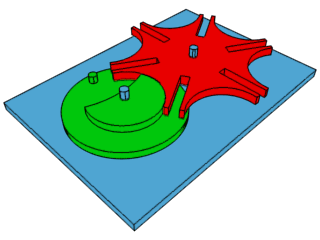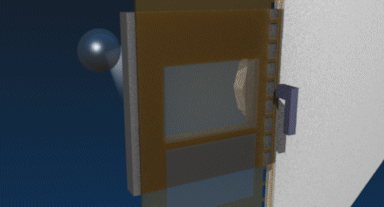
Intermittent mechanism
Encyclopedia


Film
A film, also called a movie or motion picture, is a series of still or moving images. It is produced by recording photographic images with cameras, or by creating images using animation techniques or visual effects...
is regularly advanced and then held in place for a brief duration of time in a movie camera
Movie camera
The movie camera is a type of photographic camera which takes a rapid sequence of photographs on strips of film which was very popular for private use in the last century until its successor, the video camera, replaced it...
or movie projector
Movie projector
A movie projector is an opto-mechanical device for displaying moving pictures by projecting them on a projection screen. Most of the optical and mechanical elements, except for the illumination and sound devices, are present in movie cameras.-Physiology:...
. This is in contrast to a continuous mechanism, whereby the film is constantly in motion and the image is held steady by optical or electronic scanning methods. The reason the intermittent mechanism "works" for the viewer is because of a psychological phenomenon called persistence of vision
Persistence of vision
Persistence of vision is the phenomenon of the eye by which an afterimage is thought to persist for approximately one twenty-fifth of a second on the retina....
.
History
Intermittent mechanisms were first used in sewing machines, in order for the fabric to be fed through correctly - ensuring it is stationary as each stitch is made, while moving the required distance between stitches.Methods used
The intermittent mechanism must be employed in concert with a rotating shutterShutter (photography)
In photography, a shutter is a device that allows light to pass for a determined period of time, for the purpose of exposing photographic film or a light-sensitive electronic sensor to light to capture a permanent image of a scene...
which blocks light transmittance during the motion of the film and allows light through while the film is held in place usually by one or more registration pin
Registration pin
A registration pin is a device intended to hold a piece of film, paper or other material in place during photographic exposure, copying or drawing....
s. The intermittent mechanism can be accomplished in many ways, but most often, it is done with sprocket
Sprocket
A sprocket or sprocket-wheel is a profiled wheel with teeth, cogs, or even sprockets that mesh with a chain, track or other perforated or indented material. The name 'sprocket' applies generally to any wheel upon which are radial projections that engage a chain passing over it...
wheels, claws, or pins coupled to the camera or projector drive mechanism.
In movie theater projectors, the intermittent movement is often produced by a Maltese cross
Geneva drive
The Geneva drive or Maltese cross is a gear mechanism that translates a continuous rotation into an intermittent rotary motion. The rotating drive wheel has a pin that reaches into a slot of the driven wheel advancing it by one step...
mechanism.
However, in a movie camera
Movie camera
The movie camera is a type of photographic camera which takes a rapid sequence of photographs on strips of film which was very popular for private use in the last century until its successor, the video camera, replaced it...
, it is done through a process by which a shutter
Shutter (photography)
In photography, a shutter is a device that allows light to pass for a determined period of time, for the purpose of exposing photographic film or a light-sensitive electronic sensor to light to capture a permanent image of a scene...
opens exposing the film negative to light for a split second (the standard for regular motion in North America is 1/48 of a second), then the shutter closes blocking light from reaching the negative. Once the shutter is completely closed, a claw pulls down the next frame of negative film by the sprocket holes into the film gate
Film gate
The film gate is the rectangular opening in the front of a motion picture camera where the film is exposed to light. The film gate can be seen by removing the lens and rotating the shutter out of the way...
and the process begins again. A movie projector
Movie projector
A movie projector is an opto-mechanical device for displaying moving pictures by projecting them on a projection screen. Most of the optical and mechanical elements, except for the illumination and sound devices, are present in movie cameras.-Physiology:...
works in a similar way.

